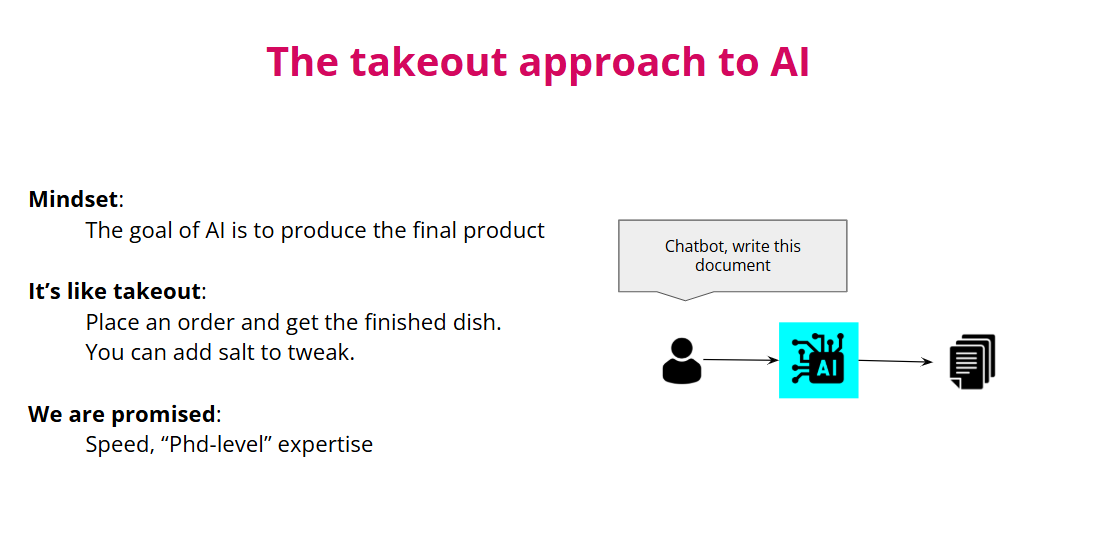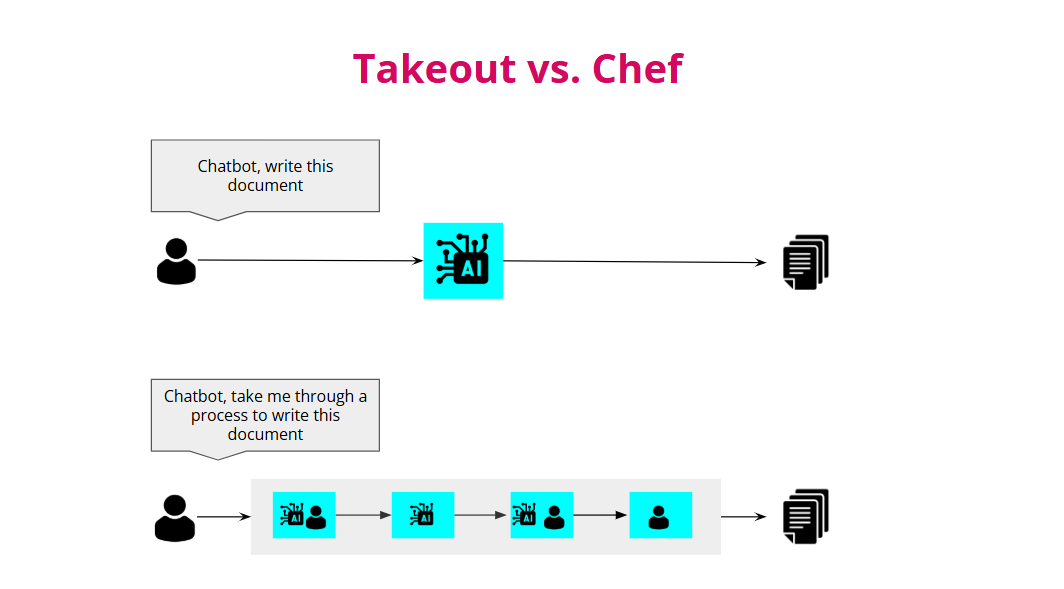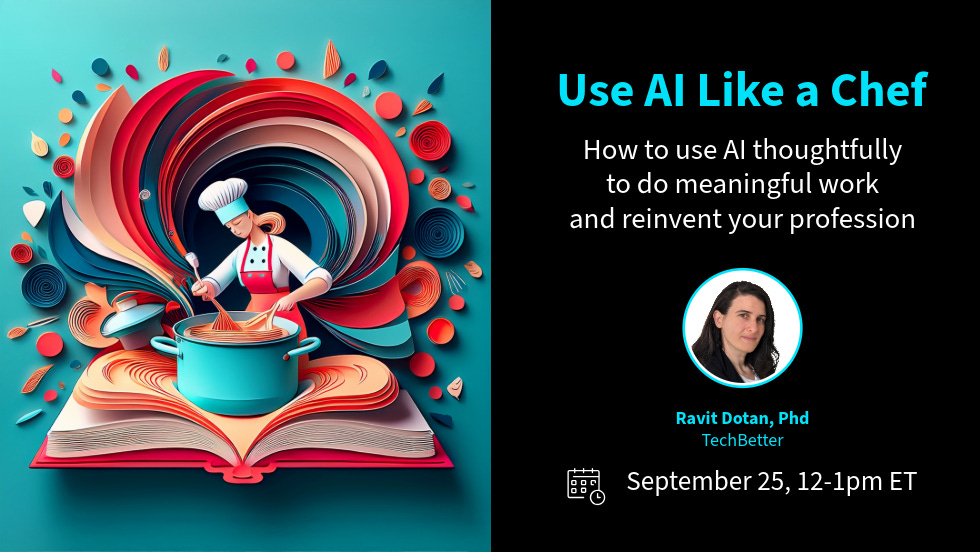Introducing: The Chef Approach to AI
A new approach to using AI thoughtfully
Hi friends,
It has been a long time since I posted, and it is because I was working on something new! I have developed a new approach to thinking and building with AI. I am calling it the Chef Approach to AI.
I experimented and iterated, using it to build AI tools for myself and my clients and to develop a course to teach it to others. Today I finished the third pilot of my course. I am excited to share it publicly today!
I'll start with how I think most people approach AI, which I am calling the "takeout" approach to AI, and then explain my chef alternative.
If you'd like to hear more and talk about it with me, I am holding a webinar on September 25. Sign up here.
And now, drumroll please….
Where We Are Now: The Takeout Trap
Most of us use AI like takeout. We hand over the entire task to the chatbot, like placing an order and waiting for the completed dish to arrive:
"Chatbot, write my email."
"Chatbot, generate an image for my presentation."
We may add a bit of salt to tweak what we get, but we are basically stuck with someone else’s menu, with no control over the ingredients, the preparation, or the outcome we will consume.
We are promised speed, productivity, and “PhD-level" intelligence. But the reality is often very different:
Low-quality outputs - the outputs often disappoint. Common reasons include failing to capture what you have in mind, containing hallucinations and other errors, such as bias, and so on.
Counterproductive speed - the heightened emphasis on speed can become counterproductive. You can end up moving faster to nowhere, like roller skating on a treadmill.
Dependency - many feel they are eroding skills, becoming reliant on chatbots, and that their jobs are at risk. When we focus on finding that perfect prompt to give us the perfect output, we start wondering if there's any need for us at all.
The Chef Alternative: A Different Way Forward
There's another way to think about what to do with AI.
Consider what a chef does.
A chef doesn't just order ingredients and hope for the best. They design recipes based on their vision and expertise. They choose ingredients, methods, timing, and techniques. Then they actively manage the execution, tasting as they go, adjusting seasoning, deciding when something is ready.
The chef approach to AI works the same way:
The chef approach to AI: Instead of handing over entire tasks to AI tools, you design processes that incorporate AI strategically. You stay involved throughout, making decisions and managing the execution. You remain the expert and the decision maker.
The key difference is that AI becomes part of your workflow rather than replacing your workflow. You're not in AI's loop waiting to approve outputs. AI is in your loop, helping you execute your process more effectively.
Example: the chef approach to AI writing
I'll illustrate with a real example. I used the chef approach to build a writing process for Emily Crookston, a business book ghostwriter.
The core insight is to break your task into sub-tasks and, instead of using AI to generate the final outcome, use it to take you through a process to think more deeply about what you're trying to do.
Emily and I broke Emily's ghostwriting process into four parts:
Ideation - Developing book concepts with clients
Outline - Creating the book's structure
Content - Writing chapters and sections
Tone - Capturing the client's authentic voice.
In each part, we figured out how Emily could use AI to think better about what she was trying to accomplish. Let’s zoom in on writing outlines as an example.
The takeout approach would be prompting for an outline, e.g., "Create an outline for a business book about leadership."
Instead, we designed a process for Emily to think through potential outlines, a custom chatbot that took Emily through for generating and revising outline options.
In the chef approach, Emily uses AI to produce multiple canadiate outlines at the same time and using them for faster iteration. It helps her see where the concept could go and reflect on it more effectively.
This approach doesn't come at the expense of productivity. While Emily’s process is slower than just generating an outline (which is what you would do in the takeout approach), it still dramatically increases productivity. In Emily's case, she went from being able to handle 6 book clients per year to being able to manage up to 100, and she hit $100K in revenue within 8 months. She maintained quality while developing her expertise further rather than replacing it.
Beyond the Cliches
The chef approach goes beyond common sayings about AI:
“Use AI to automate daily tasks" focuses on the periphery of our work, instead of its core, missing the opportunity to elevate what we do deeply.
"Humans should be in the loop" is important, but the chef approach flips this. Instead of you being in AI's loop, AI becomes part of your loop. You design the process and place AI in it where and how you see fit.
"AI is a tool" gets the basic point right, but it's more accurate to say AI is a technology for making tools. Emily and I built a custom chatbot for her process. This chatbot was the tool. AI was the underlying technology with which we could build many other tools.
What to talk about this?
If you’d like to hear more about my chef approach to talk through how it applies to your case, you are welcome to my webinar on September 25.
I will present my approach and talk through how it can be applied in the case of any participant who would be interested.






Seeing this makes me better understand your "tool v technology" distinction...AI as tech means you have agency to build SLM, tool means you are more a secondary user and have to go through a longer process to have external engineers, etc, modify the tool. Like a classroom teacher submitting user feedback for Google Classroom over the last decade. Good distinction!